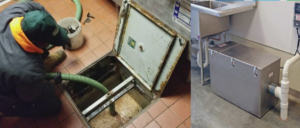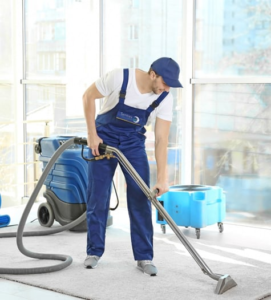Restaurants and other food service establishments that produce large volumes of FOG must install grease traps or interceptors. These devices separate fats, oils, and grease from kitchen wastewater, preventing unwanted substances from entering the sewer system and causing costly blockages requiring specialized equipment. Contact Grease Trap Perth now!
Maintaining a properly functioning grease trap requires regular cleaning and inspections. Failing to do so may lead to numerous problems, including:

A busy commercial kitchen is full of hustle and bustle, but one crucial aspect that often gets overlooked is the grease trap. When it is not properly serviced, a grease trap can become clogged, leading to a variety of issues that impact kitchen efficiency and present health and safety risks for both customers and employees. A dirty grease trap can also contaminate the surrounding environment, creating a serious environmental hazard and potentially costing your restaurant costly fines and penalties.
A properly maintained grease trap helps to prevent unwanted grease from entering public sewers by preventing it from passing through drains and being deposited into the sewer system. It is important to regularly clean your grease trap and to keep an eye on its capacity so that you can get it pumped before it reaches the one-quarter point. Depending on the type of food establishment, grease production will vary significantly, which can affect how quickly your trap will fill up and need to be pumped out.
Keeping your grease trap in good condition will also help to extend the life of your drains and plumbing system, reducing the need for expensive repairs. It will also reduce foul odors that can impact your dining and cooking areas, improving the customer experience and providing a healthier working environment for staff.
Regularly cleaning a grease trap can also help to ensure that any remaining grease is disposed of in compliance with environmental regulations, which protects the surrounding community and the water supply. If you dispose of grease improperly, it can contaminate wastewater and enter the public sewer system, where it can cause blockages that result in costly repairs for your restaurant.
A poorly maintained grease trap can overflow and spill into the kitchen and dining areas, causing unpleasant odors that can be very difficult to eliminate. This can create a negative customer experience and damage your reputation, so it is important to have your grease trap regularly cleaned by a professional.
Reduced Risk of Drain Backups and Overflows
A grease trap helps mitigate the risks of plumbing emergencies by catching food waste before it enters drains and sewer systems. It also helps prevent unpleasant odors and health hazards, such as pathogens.
If grease and other food scraps are allowed to drain into a sewer system, it can lead to massive blockages that cause costly repairs. This can also pollute the environment and put public health at risk. Food service businesses are expected to catch FOG before it enters a sewer system, and a properly maintained grease trap is essential for this.
FOG cools down and solidifies into a wax-like substance that can adhere to different surfaces, causing blockages. A commercial kitchen grease trap catches this waste and protects the surrounding environment from toxic gas emissions, food contamination, and structural damage to the drainage system.
Regular inspections and cleanings of a grease trap can help prevent clogs and reduce waste buildup. Educating staff on best practices for reducing food waste can also help. Simple measures like encouraging them to scrape dishes into trash receptacles before washing and using sink strainers can minimize the amount of grease that ends up in the trap. In addition, reusing cooking oil rather than pouring it down the drain can save restaurants money while reducing environmental pollution.
Plumbing emergencies caused by blocked or overflowing drains can damage equipment, create unpleasant odors, and disrupt business operations. They can even lead to a loss of revenue. Grease trap maintenance can identify problems early and resolve them promptly, avoiding the cost of expensive repairs and replacements.
A poorly maintained grease trap can become clogged with solidified grease and food waste, causing slow drainage and blocking drains and sinks. This can lead to customer dissatisfaction, sanitation issues, and legal or health department fines. Regular grease trap maintenance and cleaning can ensure optimum performance and compliance with regulations.
Regular grease trap cleanings keep FOG at bay and extend the life of a drainage system. Having a qualified professional handle this task can ensure that the grease trap is cleaned and emptied in accordance with local regulations. Professionals can also monitor the trap’s performance, including the level of FOG present, to detect potential clogs or other problems before they occur.
Extends Equipment Life
A grease trap separates fats, oils, and grease (often abbreviated to FOG) from wastewater, allowing only water to pass into the sewer system. Without a properly functioning grease trap, these fatty substances would accumulate in drains and pipes, leading to costly clogs and other plumbing emergencies that can shut down kitchen operations. Regular grease trap cleanings ensure that your facility can run smoothly.
Professional cleaning of commercial grease traps enables you to take proactive measures to reduce the amount of FOG that goes into the sewer system and keeps your grease trap in good condition. Having experts clean the trap helps you see potential problems with baffles, outlets, and other components before they become major issues that require expensive repairs or replacement. Keeping the grease trap in good condition will also allow you to get more life out of the unit and save money in the long run.
A poorly functioning grease trap is a health and sanitation hazard for your staff and customers. It emits foul odors, attracts flies and other insects, and can lead to a host of other problems that can make running your restaurant difficult.
Grease traps should be sized appropriately to the volume of food that your establishment processes. An improperly sized trap can create a lot of waste and lead to costly overflows and clogs. Professional cleaning of the trap and proper sizing help ensure that your facility operates safely, efficiently, and within local regulations.
Local authorities don’t take kindly to grease traps that overflow into public sewers. The resulting mess is harmful to aquatic life and the underlying sewer system and can result in hefty fines for your business. Regular cleaning and pumping of the trap prevents overflows and maintains a healthy working environment inside your restaurant.
Taking a proactive approach to your kitchen grease management can prevent problems before they happen, extend the lifespan of your equipment, and keep your staff happy and productive. Keeping up with routine grease trap cleaning in Boca Raton, regular inspections by skilled professionals, and encouraging your staff to practice small daily habits can help you achieve these goals.
Prevents Environmental Pollution
FOG clogs and backups can cause raw sewage to overflow into local waterways, polluting the environment with bacteria and posing a health risk for anyone who comes into contact with it. Regular grease trap cleaning prevents these clogs and overflows, keeping local waterways clean and safe for all to use.
Keeping your trap functioning properly also reduces the strain on your community’s sewer systems. When you dispose of your FOG waste responsibly, you help to reduce blockages and overflows that can damage infrastructure and cost taxpayer dollars for repair.
In addition, failing to maintain your grease trap can result in costly environmental fines. Each state and municipality has its own waste compliance laws and regulations, which you must adhere to in order to avoid legal repercussions. Neglecting your trap can lead to a wide range of environmental impacts, including water contamination, air pollution, and soil degradation.
For example, a restaurant in California was recently fined for causing a major sewage overflow after accumulating too much FOG in the sewer system. This overflow caused raw sewage to flow into the city’s streets and contaminated nearby water bodies with harmful bacteria and chemicals.
The EPA recommends using chemically-treated grease traps to protect the environment and reduce the risk of oil spills. Chemical treatment reduces the amount of hydrogen sulfide gas (H2S) that forms inside of your trap. H2S is highly toxic and corrodes concrete and metal equipment within your trap. Chemically treating your trap as part of your preventative maintenance schedule helps to keep the toxicity levels in your establishment below regulatory standards.
In addition to protecting the environment, regularly maintaining your grease trap can also help to improve customer loyalty. When customers see that your business is dedicated to environmentally sustainable practices, they know that you value their trust and support. In addition, customers will be more likely to frequent your establishment again and recommend it to friends and family. Moreover, implementing a biodigester as part of your grease trap recycling program reduces the volume of waste that reaches sewage treatment plants, further reducing the strain on local infrastructure.








